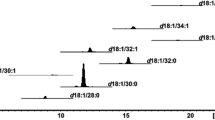Abstract
A selected group of diabetic patients showed a statistically significant increase in levels of glycated proteins in the stratum corneum compared with a control group. The values of glycated proteins correlated with those of glycohaemoglobin (GHb), and in diabetic patients also with serum glucose concentrations. The values of glycated proteins (and GHb) exhibited a positive correlation with age both in a control group and in diabetic patients. The average values of glycated proteins (and GHb) were slightly higher in women than in men. Determination of glycated proteins levels of the stratum corneum can serve as a stable parameter for long-term monitoring of the course of non-enzymatic glycation in structural and connective tissues and thus also for the prognosis of the development of dermatological complications related to diabetes mellitus. In vitro incubation of stratum corneum proteins and keratin with glucose resulted in an increase of their glycation. The values of glycated proteins and glycated keratin increased proportionally to the glucose concentration and duration of incubation. Glucose binding to keratin and proteins of the insoluble stratum corneum fraction appeared to occur at practically the same rate, and it is a first-order reaction with regard to the glucose concentration. Water-soluble proteins of the stratum corneum undergo non-enzymatic glycation preferentially (on average 83.4% of the total amount of glycated proteins is present in the soluble fraction), regardless of the initial content of glycated proteins in the sample. The content of glycated soluble proteins of a higher molecular weight significantly increased after 4 weeks of incubation with glucose.
Similar content being viewed by others
References
Maillard LC, Reaction generale des acides amines sur le sucres: ses consequences biologiques. CR Acad Sci 154:66–68, 1912
Rahbar S, An abnormal haemoglobin in red cells of diabetics. Clin Chim Acta 22:296–298, 1968
Gabbay KH, Sosenko JS, Banuch GA, Minisohn MJ, Flückiger R, Glycosylated haemoglobins: increased glycosylation of haemoglobin A in diabetic patients. Diabetes 28:337–340, 1979
Bunn HF, Gabbay KH, Gallop PM, The glycosylation of haemoglobin: relevance to diabetes mellitus. Science 200:21–27, 1978
Rácz O, Vícha T, Pačin J, Glycohaemoglobin, glycation of proteins and diabetes mellitus. Osveta Martin (SR), 1989
Monnier VM, Kohn RR, Cerami A, Accelerated age-related browning of collagen in diabetes mellitus. Proc Natl Acad Sci USA 81:583–587, 1984
Brownlee M, Cerami A, Vlassara H, Advanced glycosylation end-products in tissue and the biochemical basis of diabetic complications. N Engl J Med 318:1315–1321, 1988
Monnier VM, Stevens VJ, Cerami A, Nonenzymatic glycosylation, sulfhydryloxidation and aggregation of lens proteins in experimental sugar cataracts. J Exp Med 150:1098–1107, 1979
Day JF, Thorpe SR, Bayers JW, Nonenzymatically glucosylated albumin. J Biol Chem 254:595–597, 1979
Schnider SL, Kohn RR, Effect of age and diabetes mellitus on the solubility and non-enzymatic glycosylation of human skin collagen. J Clin Invest 67:1630–1635, 1981
Schnider SL, Kohn RR, Glycosylation of human collagen in aging and diabetes mellitus. J Clin Invest 66:1179–1181, 1980
Delbridge L, Ellis CS, Robertson K, Lequesne LP, Non-enzymatic glycosylation of keratin of the stratum corneum of the diabetic foot. Br J Dermatol 112:547–554, 1985
Paisey RB, Clamp JR, Kent MJC, Light ND, M, Hartog M, Glycosylation of hair: possible measure of chronic hyperglycaemia. Br Med J 288:669–671, 1984
Bakan E, Bakan N, Glycosylation of nail in diabetics: possible marker of long-term hyperglycaemia. Clin Chim Acta 147:1–5, 1985
Lowry OH, Rosenbrough NJ, Farr AL, Randall RJ, Protein measurement with the Folin-phenol reagent. J Biol Chem 193:265–275, 1951
Sehnalová H, Záhejský J, Photometric determination of glycosylated epidermal keratin. Biochem Clin Bohemoslov 19:351–358, 1990
Flückiger R, Winterhalter KH, In vitro synthesis of haemoglobin A1c. FEBS Lett 71:356–360, 1976
Ghusyen JM, Tipper DJ, Strominger JL, Enzymes that degrade bacterial cell walls. Methods Enzymol 8:695, 1966
Racek P, The optimized SDS-polyacrylamide gel electrophoresis using a gradient of N, N-methylene-bis-acrylamide. Bull Czech Biol Soc 11:101, 1983
Laemmli UK, Cleavage of structural proteins during the assembly of the head of bacteriophage T 4. Nature 227:680–683, 1970
Hook B, Neufahrt A, Leonhardi C, Separation of water proteins in psoriatic scales with different polyacrylamide gel concentrations and molecular weight estimations of the separated bands by disc electrophoresis. Arch Dermatol Forsch 250:245–252, 1974
Yamauchi M, Woodley DT, Mechanic GL, Aging and cross-linking of skin collagen. Biochem Biophys Res Commun 152:898–903
Kasai K, Nakamura T, Kan N, Suzuki R, Fogure R, Shimoda S, Increased glycosylation of proteins from cataractous lenses in diabetes. Diabetologia 25:36, 1983
Hödl S, Skin disorders in diabetes mellitus. Acta Derm Venerol 1:71–76, 1992
Vishwanath V, Frank KE, Elmets CA, Dauchot PJ, Monnier VM, Glycation of skin collagen in type I diabetes mellitus. Correlation with long term complications. Diabetes 35:916–921, 1986
Brownlee M, Pongor S, Cerami A, Covalent attachment of soluble proteins by nonenzymatically glycosylated collagen. J Exp Med 158:1739–1744, 1983
Stickland MH, Paton RC, Wales JK, Haemoglobin A1c concentrations in men and women with diabetes. Br Med J 289:733–739, 1984
Oimoni M, Masumoto S, Hatanaka H, Hemoglobin A1 and hemoglobin A1c in elderly diabetes. Kobe J Med Sci 31:95–101, 1985
Graf JR, Halter JB, Porte D, Glycosylated hemoglobin in normal subjects and subjects with maturity-onset diabetes. Diabetes 27:843–839, 1978
Monnier VM, Cerami A, Non-enzymatic browning in vivo: possible process for aging of long-lived proteins. Science 211:491–493, 1981
Yascoff RW, Tevaarwerk GJM, MacDonald JC, Quantification of nonenzymatically glycated albumin and total serum protein by affinity chromatography. Clin Chem 30:446–449, 1984
Day JF, Thornburg RW, Thorpe SR, Bayness JW, Nonenzymatic glycation of rat albumin. J Biol Chem 254:9394–9400, 1979
Author information
Authors and Affiliations
Rights and permissions
About this article
Cite this article
Márová, I., Záhejský, J. & Sehnalová, H. Non-enzymatic glycation of epidermal proteins of the stratum corneum in diabetic patients. Acta Diabetol 32, 38–43 (1995). https://doi.org/10.1007/BF00581043
Received:
Accepted:
Issue Date:
DOI: https://doi.org/10.1007/BF00581043




